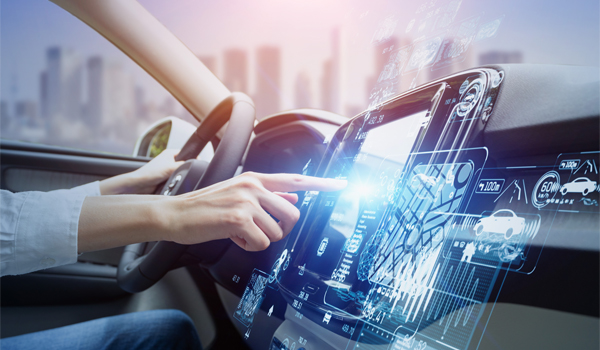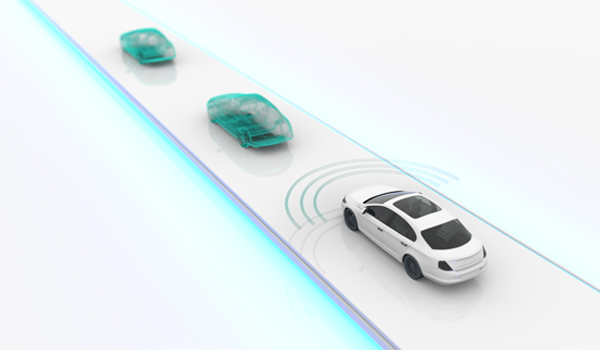MEMS Applications in the Automotive Industry

MEMS devices, which are being adopted in a variety of industries and are replacing existing components, are also spreading to automotive components. In addition to use in internal combustion engine (ICE) driven vehicles, demand for MEMS devices is expected to grow further with the shift to electric vehicles (EVs).
- Types and Roles of MEMS Sensors for Automotive Applications
- MinebeaMitsumi’s MEMS Devices Utilized in the Automotive Industry
Types and Roles of MEMS Sensors for Automotive Applications
Sensors made with MEMS technology are indispensable not only for ICE, but also for the shift to EVs. Many devices made with MEMS technology are used to realize autonomous driving, which is drawing growing attention.
MEMS Technology Supporting Automobiles, from Gasoline Cars to EVs
Numerous MEMS sensors are used in ICE vehicles. To give one example, a variety of MEMS pressure sensors are used in engine control to detect gases, liquids, and other substances. The pressure sensors used for detection are installed in a variety of environments and are packaged for a wide range of conditions.
Besides engines, other applications of pressure sensors include the detection of tire pressure (TPMS), which is already mandatory in Europe and other countries. Also, battery monitoring technology using pressure sensors is being developed to prevent the thermal runaway phenomenon of lithium-ion batteries used in EVs.
Engine-related pressure sensors
- Intake air
- Manifold pressure (MAP), atmospheric pressure (BAP)
- Exhaust gas
- Exhaust gas particulate filter (GPF: gasoline/DPF: diesel), exhaust gas recirculation (EGR)
- Gasoline tank
- Gasoline tank leak prevention (EVAP)
- Others
- Engine oil, transmission oil
Non-engine related pressure sensors
Tire pressure (TPMS), HVAC, battery monitoring, etc.
MEMS Sensors Used in a Variety of Embedded Applications
As the shift from ICE powered to electric vehicles continues, “infotainment” is attracting particular attention. Infotainment is an in-vehicle system that provides the information and entertainment elements of a vehicle, and the name was coined by combining these two words.
The components that support this infotainment use multiple MEMS devices, including MEMS sensors.
For example, car navigation systems use various MEMS sensors such as accelerometers, gyro sensors, and magnetic sensors to display various information on the screen in conjunction with the movement of the car. Accelerometers are also used in airbags to help inflate the airbags by reading the impact when the car collides with something.
MEMS microphones are used for audio input to the navigation system, MEMS speakers are used as in-car speakers, and MEMS mirrors are used as part of the head-up display (HUD). Recently, MEMS speakers have been increasingly used for in-car surround sound systems. MEMS speakers, which are used in wearable wireless earphones and other products, have the advantage of being ultra-compact, ultra-lightweight, and energy efficient. Placing them in the seats, ceiling, doors, and other locations of the vehicle cabin can provide powerful three-dimensional acoustics, and even if many speakers are installed, they take up less space and reduce the weight of the cabin compared to conventional speaker systems.
MEMS sensors are also used for sensing the air flow in HVAC (heating, ventilation, and air conditioning), which controls the air conditioning inside the car. In coming years, as automated driving evolves, more attention will also be focused on the environment inside the car. Designers will also place greater focus on detecting the air quality inside the car, such as CO2 concentration, and MEMS sensors are expected to be used for such measurements. Also, research and development using odor sensing devices to create a more comfortable cabin space is progressing, and it is expected that an even greater variety of MEMS devices will be installed in vehicles in the future.
MinebeaMitsumi’s MEMS Devices Utilized in the Automotive Industry
MinebeaMitsumi provides a variety of MEMS devices for automotive manufacturing for the CASE era. In particular, research and development and demonstration tests of automated driving technology have been conducted by various manufacturers, and practical application of the technology is just around the corner. MinebeaMitsumi supplies the MEMS devices used in LiDAR, which is an important piece in the realization of this automated driving technology.
MEMS Mirrors Used in LiDAR

As various studies and experiments are being conducted toward the realization of automated driving, a technology called light detection and ranging (LiDAR) is drawing increasing attention. This technology detects the shape and movement of an object by irradiating a laser onto the surrounding object and performing 2D or 3D sensing.
Various devices are used to scan the laser over a wide area. In the past, motors were used in LiDAR, but development of LiDAR using MEMS mirrors, which can be made smaller, is currently underway.
In addition to conventional motors and MEMS devices, MinebeaMitsumi is also developing a device that can control the LiDAR mirror angle at high speed and with high accuracy using a limited angle torque motor (LATM)*, which is a rotary reciprocating actuator that was developed from our proprietary magnetic circuit design.
